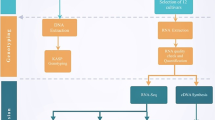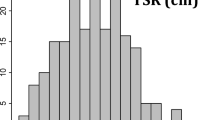Abstract
Synthetic hexaploid wheat (SHW) possesses numerous genes for resistance to stress, including phosphorus (P) deficiency. Root diameter (RDM) plays an important role in P-deficiency tolerance, but information related to SHW is still limited. Thus, the objective of this study was to investigate the genetic architecture of RDM in SHW under P-deficient conditions. To this end, we measured the RDM of 138 F9 recombinant inbred lines derived from an F2 population of a synthetic hexaploid wheat line (SHW-L1) and a common wheat line (Chuanmai32) under two P conditions, P sufficiency (PS) and P deficiency (PD), and mapped quantitative trait loci (QTL) for RDM using an enriched high-density genetic map, containing 120,370 single nucleotide polymorphisms, 733 diversity arrays technology markers, and 119 simple sequence repeats. We identified seven RDM QTL for P-deficiency tolerance that individually explained 11–14.7% of the phenotypic variation. Five putative candidate genes involved in root composition, energy supply, and defense response were predicted. Overall, our results provided essential information for cloning genes related to P-deficiency tolerance in common wheat that might help in breeding P-deficiency-tolerant wheat cultivars.






Similar content being viewed by others
References
Atkinson D (1990) Influence of root system morphology and development on the need for fertilizers and the efficiency of use. In: Baligar VC, Duncan RR (eds.) Crops as enhancers of nutrient use. Academic Press, San Diego, pp. 411–450
Bar M, Aharon M, Benjamin S, Rotblat B, Horowitz M, Avni A (2008) AtEHDs, novel Arabidopsis EH-domain-containing proteins involved in endocytosis. Plant J 55:1025–1038
Beebe SE, Rojas-Pierce M, Yan X, Blair MW, Pedraza F, Munoz F, Tohme J, Lynch JP (2006) Quantitative trait loci for root architecture traits correlated with phosphorus acquisition in common bean. Crop Sci 46:413–423
Boulaflous A, Saintjoredupas C, Herranzgordo MC, Pagnysalehabadi S, Plasson C, Garidou F, Kiefermeyer MC, Ritzenthaler C, Faye L, Gomord V (2009) Cytosolic N-terminal arginine-based signals together with a luminal signal target a type II membrane protein to the plant ER. BMC Plant Biol 9:1–22
Cahn M, Zobel R, Bouldin D (1989) Relationship between root elongation rate and diameter and duration of growth of lateral roots of maize. Plant Soil 119:271–279
Cao P, Ren Y, Zhang K, Teng W, Zhao X, Dong Z, Liu X, Qin H, Li Z, Wang D (2014) Further genetic analysis of a major quantitative trait locus controlling root length and related traits in common wheat. Mol Breed 33:975–985
Chang IF, Curran A, Woolsey R, Quilici D, Cushman JC, Mittler R, Harmon A, Harper JF (2009) Proteomic profiling of tandem affinity purified 14-3-3 protein complexes in Arabidopsis thaliana. Proteomics 9:2967–2985
Chen HY, Yu HY, Chen GD, Li YX (2015) Root morphological characteristics of barley genotype with high phosphorus efficiency under phosphorus stress. Chin J Appl Ecol 26(10):3020–3026 (in Chinese with English abstract)
Chen J, Xu L, Cai Y, Xu J (2009) Identification of QTLs for phosphorus utilization efficiency in maize (Zea mays L.) across P levels. Euphytica 167:245–252
Coudert Y, Périn C, Courtois B, Khong NG, Gantet P (2010) Genetic control of root development in rice, the model cereal. Trends Plant Sci 15:219–226
Den Herder G, Van Isterdael G, Beeckman T, De Smet I (2010) The roots of a new green revolution. Trends Plant Sci 15:600–607
Fernández-Marcos M, Desvoyes B, Manzano C, Liberman LM, Benfey PN, Del Pozo JC, Gutierrez C (2016) Control of Arabidopsis lateral root primordium boundaries by MYB36. New Phytol 213:105
Fitter AH (1991) Characteristics and functions of root systems. Plant roots: the hidden half 2:1–29
Fitter AH, Hay RK (2012) Environmental physiology of plants. Academic Press, San Diego
Furumizu C, Komeda Y (2008) A novel mutation in KNOPF uncovers the role of α-glucosidase I during post-embryonic development in Arabidopsis thaliana. FEBS Lett 582:2237–2241
Gahoonia TS, Nielsen NE (2004) Root traits as tools for creating phosphorus efficient crop varieties. Plant Soil 260(1–2):47–57
Gillmor CS, Poindexter P, Lorieau J, Palcic MM, Somerville C (2002) Alpha-glucosidase I is required for cellulose biosynthesis and morphogenesis in Arabidopsis. J Cell Biol 156:1003
Goddard ME (1992) A mixed model for analyses of data on multiple genetic markers. Theor Appl Genet 83(6–7):878–886
Guo C, Guo L, Li X, Gu J, Zhao M, Duan W, Ma C, Lu W, Xiao K (2014) TaPT2, a high-affinity phosphate transporter gene in wheat (Triticum aestivum L.), is crucial in plant Pi uptake under phosphorus deprivation. Acta Physiol Plant 36:1373–1384
Guo C, Zhao X, Liu X, Zhang L, Gu J, Li X, Lu W, Xiao K (2013) Function of wheat phosphate transporter gene TaPHT2; 1 in Pi translocation and plant growth regulation under replete and limited Pi supply conditions. Planta 237:1163–1178
Guo Y, Kong FM, Xu YF, Zhao Y, Liang X, Wang YY, An DG, Li SS (2012) QTL mapping for seedling traits in wheat grown under varying concentrations of N, P and K nutrients. Theor Appl Genet 124:851–865
Hayes J, Richardson A, Simpson R (2000) Components of organic phosphorus in soil extracts that are hydrolyzed by phytase and acid phosphatase. Biol Fertil Soils 32:279–286
Hill JO, Simpson RJ, Moore AD, Chapman DF (2006) Morphology and response of roots of pasture species to phosphorus and nitrogen nutrition. Plant Soil 286(1):7–19
Hoagland DR, Arnon DI (1950) The water-culture method for growing plants without soil. Circular (California Agricultural Experiment Station 347). College of Agriculture, University of California, Berkeley CA
Holford ICR (1997) Soil phosphorus: its measurement, and its uptake by plants. Soil Research 35(2):227–240
Huiru LZNZP, Shengbao LZNXX, Qixin LGS (2007) Molecular mapping of QTLs for root response to phosphorus deficiency at seedling stage in wheat (Triticum aestivum L.) Prog Nat Sci 17:1177–1184
Kamiya T, Borghi M, Wang P, Danku JM, Kalmbach L, Hosmani PS, Naseer S, Fujiwara T, Geldner N, Salt DE (2015) The MYB36 transcription factor orchestrates Casparian strip formation. Proc Natl Acad Sci U S A 112:10533–10538
Lage J, Skovmand B, Andersen SB (2003) Expression and suppression of resistance to greenbug (Homoptera: Aphididae) in synthetic hexaploid wheats derived from Triticum dicoccum × Aegilops tauschii crosses. J Econ Entomol 96:202–206
Liberman LM, Sparks EE, Moreno-Risueno MA, Petricka JJ, Benfey PN (2015) MYB36 regulates the transition from proliferation to differentiation in the Arabidopsis root. Proc Natl Acad Sci U S A 112:12099–12104
Liu X, Zhao X, Zhang L, Lu W, Li X, Xiao K (2013) TaPht1; 4, a high-affinity phosphate transporter gene in wheat (Triticum aestivum), plays an important role in plant phosphate acquisition under phosphorus deprivation. Funct Plant Biol 40:329–341
Liu Y, Wang L, Deng M, Li Z, Lu Y, Wang J, Wei Y, Zheng Y (2015) Genome-wide association study of phosphorus-deficiency-tolerance traits in Aegilops tauschii. Theor Appl Genet 128:2203–2212
Ma J, Zheng Z, Stiller J, Lan XJ, Liu Y, Deng M, Wei Y (2016) Identification and characterization of genes on a single subgenome in the hexaploid wheat (Triticum aestivum L.) genotype ‘Chinese Spring’. Genome 60(3):208–215
Mares D, Mrva K (2008) Genetic variation for quality traits in synthetic wheat germplasm. Crop and Pasture Science 59:406–412
Mudge SR, Smith FW, Richardson AE (2003) Root-specific and phosphate-regulated expression of phytase under the control of a phosphate transporter promoter enables Arabidopsis to grow on phytate as a sole P source. Plant Sci 165:871–878
Pages L (1995) Growth patterns of the lateral roots of young oak (Quercus robur) tree seedlings. Relationship with apical diameter. New Phytol 130:503–509
Piepho H, Möhring J, Melchinger A, Büchse A (2008) BLUP for phenotypic selection in plant breeding and variety testing. Euphytica 161:209–228
Qiu XQ, Cao Y, Huang L et al (2013) Temporal and spatial distribution of root morphology of winter wheat. Agric Sci China 46(11):2211–2219 (in Chinese with English abstract)
Raghothama KG (1999) Phosphate acquisition. Annu Rev Plant Biol 50(1):665–693
Saint-Jore-Dupas C, Nebenführ A, Boulaflous A, Follet-Gueye ML, Plasson C, Hawes C, Driouich A, Faye L, Gomord V (2006) Plant N-glycan processing enzymes employ different targeting mechanisms for their spatial arrangement along the secretory pathway. Plant Cell 18:3182–3200
Sattelmacher B, Horst WJ, Becker HC (1994) Factors that contribute to genetic variation for nutrient efficiency of crop plants. J Plant Nutr Soil Sci 157(3):215–224
Sharpley A (1985) Phosphorus cycling in unfertilized and fertilized agricultural soils. Soil Sci Soc Am J 49:905–911
Su JY, Zheng Q, Li HW, Li B, Jing RL, Tong YP, Li ZS (2009) Detection of QTLs for phosphorus use efficiency in relation to agronomic performance of wheat grown under phosphorus sufficient and limited conditions. Plant Sci 176:824–836
Su J, Xiao Y, Li M, Liu Q, Li B, Tong Y, Jia J, Li Z (2006) Mapping QTLs for phosphorus-deficiency tolerance at wheat seedling stage. Plant Soil 281:25–36
Trethowan R, Mujeeb-Kazi A (2008) Novel germplasm resources for improving environmental stress tolerance of hexaploid wheat. Crop Sci 48:1255–1265
Wang L, Liu K, Mao S, Li Z, Lu Y, Wang J, Liu Y, Wei Y, Zheng Y (2015) Large-scale screening for Aegilops tauschii tolerant genotypes to phosphorus deficiency at seedling stage. Euphytica 204:571–586
Yadav J, Verma JP, Jaiswal DK, Kumar A (2014) Evaluation of PGPR and different concentration of phosphorus level on plant growth, yield and nutrient content of rice (Oryza sativa). Ecol Eng 62:123–128
Yang J (2016) QTL mapping for pre-harvest sprouting resistance and molecular characterization of six grain germination-related genes in synthetic wheat. Triticeae Research Institute, Sichuan Agricultural University 23-25. (in Chinese with English abstract)
Yang W, Liu D, Li J, Zhang L, Wei H, Hu X, Zheng Y, He Z, Zou Y (2016) Synthetic hexaploid wheat and its utilization for wheat genetic improvement in China. J Genet Genomics 36:539–546
Yu M, Chen GY, Zhang LQ, Liu YX, Liu DC, Wang JR, Pu ZE, Zhang L, Lan XJ, Wei YM (2014) QTL mapping for important agronomic traits in synthetic hexaploid wheat derived from Aegiliops tauschii ssp. tauschii. J Integr Agric 13:1835–1844
Zhao C, Craig JC, Petzold HE, Dickerman AW, Beers EP (2005) The xylem and phloem transcriptomes from secondary tissues of the Arabidopsis root-hypocotyl. Plant Physiol 138(2):803–818
Acknowledgements
This study was supported by the National Key Research and Development Program of China (2016YFD0101004), the Outstanding Youth Foundation of the Department of Science and Technology of Sichuan Province (2016JQ0040), the Key Technology Research and Development Program of the Department of Science and Technology of Sichuan Province (2016NZ0057), the International Science & Technology Cooperation Program of the Bureau of Science and Technology of Chengdu China (No. 2015DFA306002015-GH03-00008-HZ).
Author information
Authors and Affiliations
Contributions
FW conducted data analysis and drafted the manuscript.
XY, ZW, and MD performed the phenotypic evaluation and help to data analysis.
JM helped to analyze QTL mapping.
GC performed part of population construction.
YW participated in the design of the study.
YL designed and coordinated this study and revised the manuscript.
All authors have read and approved the final manuscript.
Corresponding author
Ethics declarations
Competing interests
The authors declare that they have no competing interests.
Additional information
Communicated by: Barbara Naganowska
Electronic supplementary material
ESM 1
(XLSX 489 kb)
Rights and permissions
About this article
Cite this article
Wu, F., Yang, X., Wang, Z. et al. Identification of major quantitative trait loci for root diameter in synthetic hexaploid wheat under phosphorus-deficient conditions. J Appl Genetics 58, 437–447 (2017). https://doi.org/10.1007/s13353-017-0406-5
Received:
Revised:
Accepted:
Published:
Issue Date:
DOI: https://doi.org/10.1007/s13353-017-0406-5




